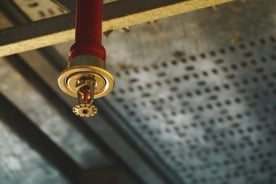According to the National Fire Protection Association (NFPA), there’s a new structure fire every 63 seconds. Many commercial buildings are equipped with sprinkler systems, which are very effective when activated. Research by the NFPA concluded sprinklers were effective at controlling fire in 96 percent of fires in which they operated.
It’s important to work with your fire protection contractor to fully understand how your system works and how to keep it properly maintained. Building owners often incorrectly assume the fire sprinkler contractor will manage their system for them. Without understanding your building’s sprinkler system, your building could be at risk of a large fire loss.
Common Types of Fire Sprinkler Systems
Wet Pipe Systems – Wet pipe sprinkler systems are the most common. When heat activates a sprinkler head, pressurized water stored in the pipes is released. Each sprinkler head is activated individually, which can help reduce water damage in the event of a false alarm.
Dry Pipe Systems – Dry pipe sprinkler systems don’t store water in their pipes. Instead, the pipes are filled with pressurized air. When a sprinkler head is activated, the gas is released and the pipes fill with water and discharge. This type of system is typically more complex and used in buildings or sections of buildings that are susceptible to cold temperatures.
Pipe Schedule Systems – Pipe schedule systems select the pipe sizing from a schedule that’s determined by the occupancy classification. The number of sprinklers allowed is specified based on the sizes of the pipes. In this type of system, the designer must know the hazard classification of the building or contents to be protected, the amount and duration of the water supply, and the specific placement of the sprinklers. This type of design gave way to hydraulically designed systems around the mid-1970s, but many buildings still have systems that were designed using a schedule. According to NFPA 13, pipe schedule systems cannot protect extra hazard occupancies.
Hydraulic Systems – Now that NFPA 13 prohibits the pipe schedule method, except in very limited instances, most systems are designed using hydraulic calculations. This type of system uses mathematical analysis of the water carrying capacity of the pipe network to ensure that enough water is put on the fire to suppress it. It’s designed to match the potential fire hazard to the pressure and volume of the available water supply.
So, what should you be doing?
- Take responsibility for maintaining your sprinkler system. Be sure you have a reputable and qualified fire sprinkler contractor inspect it annually and inform you of the condition and any deficiencies. Work with your contractor to correct any deficiencies as soon as possible.
- Know your occupancy and conditions that may affect the effectiveness of your sprinkler system. There's a common misconception that the person inspecting the system is verifying the adequacy. This isn't the case. You must work with a sprinkler designer to determine adequacy. If the sprinkler system wasn't designed for your current occupancy and storage arrangements, the system may need to be updated. Additionally, if the type of materials being stored has changed, work with your contactor to ensure the sprinkler design is still sufficient.
- Maintain a minimum of 18 inches (36” for ESFR heads) of clearance below all sprinkler heads. This allows water that’s being discharged to properly reach the fire. Depending on the design of the system and storage arrangements, sprinkler heads may need additional clearance.
- Be sure the fire department connections outside your building are visible and clear of debris. Those connections have caps that prevent foreign objects (trash, vegetation, bird nests, etc.) from obstructing their use. If caps are missing, contact your fire protection contractor to have them inspected and caps replaced.
- Know where your low point drains are located and be sure they’re labeled. If you have a dry system, you or the building owner are responsible for making sure the low point drains are drained at regular intervals.
- Have your contractor demonstrate how to shut off your system in the event of an accidental activation and ensure at least one person from each shift is trained on the process. This will help prevent or reduce water damage from the system running while you wait for the arrival of the fire department or your contractor.
- Be aware of extreme cold conditions. Cold temperatures can cause pipes to freeze and burst. When frozen, it obstructs the flow of water in the event of a fire. Be sure all areas of the building that are equipped with sprinklers have proper climate controls to prevent freezing.
- Keep detailed records of your annual inspections and tests to be used for comparisons. Comparing results can help your contractor (especially if your inspector or contactor has changed) determine system performance.
- Ensure all additional tests detailed in NFPA 25, are completed throughout the sprinkler system lifespan. This includes internal pipe exams; sprinkler head testing; and valve, waterflow alarm, and fire pump checks.
For more information, check out our safety summary on sprinkler systems.




